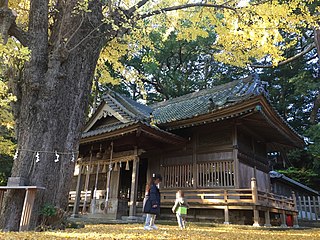Sōja is a city in Okayama Prefecture, Japan.
Contents
Soja may also refer to:
Sōja is a city in Okayama Prefecture, Japan.
Soja may also refer to:
Soya may refer to:

Sōja is a city located in Okayama Prefecture, Japan. As of 31 March 2023, the city had an estimated population of 69,428 and a population density of 330 persons per km². The total area of the city is 211.90 square kilometres (81.82 sq mi).
Joto, Jōto, or Jōtō may refer to:
The name Kamo may refer to the following:
Katsuyama may refer to:

A Shinto shrine is a structure whose main purpose is to house ("enshrine") one or more kami, the deities of the Shinto religion.
Wakamiya may refer to:
Ōmiya 大宮 is a Japanese word originally used for the imperial palace or shrines, now a common name, and may refer to:

Kibi was a kingdom of fourth century Western Japan. The Kingdom of Kibi covered most of what is today Okayama Prefecture. Today, the Kibi Road crosses the plain between Okayama and Soja, what was once the heartland of Kibi no kuni.
Fujisaki may refer to:
SOJ or variant, may refer to:
Okayama is the capital city of Okayama Prefecture in the Chūgoku region of Japan.
Tamayori-hime is a goddess in Japanese mythology. Her name is spelled as 玉依毘売命 in the Kojiki and 玉依姫 in the Nihon Shoki.

Konpira Gongen (金毘羅権現) is a Japanese god of the Shugendō sect originating in the mountain Kotohira of Kagawa Prefecture. He is the god of merchant sailors. He is worshipped at Kotohira Shrines

Yusuhara Hachiman-gū (柞原八幡宮) is a Shinto shrine located in the city of Ōita, Ōita Prefecture, Japan. It is one of two shrines claiming the title of ichinomiya of former Bungo Province, the other being the Sasamuta Jinja, also in Ōita. The shrine's main festival is held annually on March 15. It is also cometimes refrred to as Yusubara Hachiman-gū (由原八幡宮).

Sōja (総社) is a type of Shinto shrine where the kami of a region are grouped together into a single sanctuary. This "region" may refer to a shōen, village or geographic area, but is more generally referred to a whole province. The term is also occasionally called "sōsha". The sōja are usually located near the provincial capital established in the Nara period under then ritsuryō system, and can either be a newly created shrine, or a designation for an existing shrine. The "sōja" can also be the "ichinomiya" of the province, which themselves are of great ritual importance.

Kotonomama Hachiman-gū (事任八幡宮) is a Shinto shrine located in the city of Kakegawa, Shizuoka Prefecture, Japan. It is one of two shrines claiming the title of ichinomiya of former Tōtōmi Province, the other being the Oguni Jinja in the town of Mori The shrine's main festival is held annually three days prior to Respect for the Aged Day in September.

Iminomiya Shrine is a Shinto shrine located in Chōfu, Japan. It is a Beppyo shrine, or a shrine that is particularly notable in a certain way with a significant history to it. It is a Ninomiya, or a second rank shrine in its province after the Ichinomiya. In this case the Ninomiya and Soja shrine of the province are combined together. Ichinomiya and Soja shrines were often combined.
Araki Shrine (有木神社) is a Sōja shrine in Okinoshima, Shimane. It enshrines all the kami of the shrines in Oki Province.